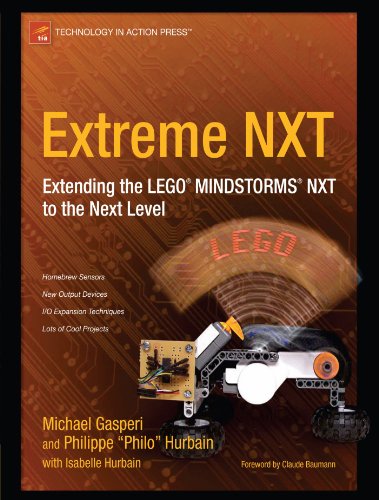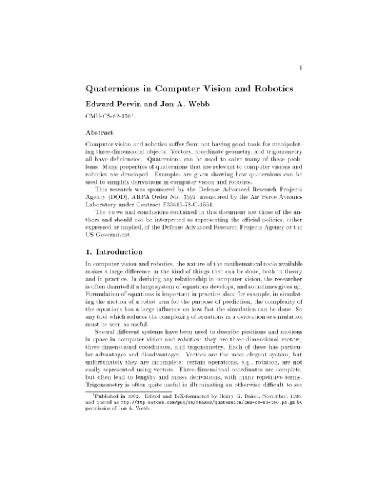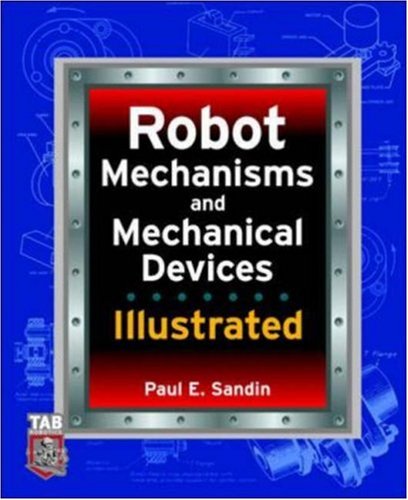José L. Pons9780470512944, 0470512946
Logical in structure and original in its global orientation, this volume gives a full overview of wearable robotics, providing the reader with a complete understanding of the key applications and technologies suitable for its development. The main topics are demonstrated through two detailed case studies; one on a lower limb active orthosis for a human leg, and one on a wearable robot that suppresses upper limb tremor. These examples highlight the difficulties and potentialities in this area of technology, illustrating how design decisions should be made based on these.
As well as discussing the cognitive interaction between human and robot, this comprehensive text also covers: the mechanics of the wearable robot and it’s biomechanical interaction with the user, including state-of-the-art technologies that enable sensory and motor interaction between human (biological) and wearable artificial (mechatronic) systems; the basis for bioinspiration and biomimetism, general rules for the development of biologically-inspired designs, and how these could serve recursively as biological models to explain biological systems; the study on the development of networks for wearable robotics.
Wearable Robotics: Biomechatronic Exoskeletons will appeal to lecturers, senior undergraduate students, postgraduates and other researchers of medical, electrical and bio engineering who are interested in the area of assistive robotics. Active system developers in this sector of the engineering industry will also find it an informative and welcome resource.
Table of contents :
Wearable Robots……Page 3
Contents……Page 9
Foreword……Page 17
Preface……Page 19
List of Contributors……Page 21
1.1 Wearable robots and exoskeletons……Page 23
1.1.1 Dual human–robot interaction in wearable robotics……Page 25
1.1.2 A historical note……Page 26
1.1.3 Exoskeletons: an instance of wearable robots……Page 27
1.2 The role of bioinspiration and biomechatronics in wearable robots……Page 28
1.2.1 Bioinspiration in the design of biomechatronic wearable robots……Page 30
1.3 Technologies involved in robotic exoskeletons……Page 31
1.4 A classification of wearable exoskeletons: application domains……Page 32
1.5 Scope of the book……Page 34
References……Page 37
2.1 Introduction……Page 39
2.2 General principles in biological design……Page 40
2.2.1 Optimization of objective functions: energy consumption……Page 41
2.2.2 Multifunctionality and adaptability……Page 43
2.2.3 Evolution……Page 44
2.3 Development of biologically inspired designs……Page 45
2.3.2 Neuromotor control structures and mechanisms as models……Page 46
2.3.3 Muscular physiology as a model……Page 49
2.3.4 Sensorimotor mechanisms as a model……Page 51
2.4 Levels of biological inspiration in engineering design……Page 53
2.4.2 Bioimitation: replication of dynamics and control structures……Page 54
2.5.2 Why is human walking efficient and stable?……Page 55
2.5.3 Robot solutions for efficiency and stability……Page 56
2.6 Case Study: MANUS-HAND, mimicking neuromotor control of grasping……Page 58
2.6.2 Design of the prosthesis……Page 59
2.6.3 MANUS-HAND control architecture……Page 61
2.7.1 Introduction……Page 62
2.7.3 Biomimetic control for an LC biped walking robot……Page 63
References……Page 65
3.1 Introduction……Page 69
3.2.1 Kinematic analysis……Page 70
3.2.2 Dynamic analysis……Page 75
3.3.1 Medical description of human movements……Page 79
3.3.2 Arm kinematics……Page 81
3.3.3 Leg kinematics……Page 83
3.3.4 Kinematic models of the limbs……Page 86
3.3.5 Dynamic modelling of the human limbs……Page 90
3.4.1 Introduction to kinematic redundancies……Page 92
3.4.2 Redundancies in human–exoskeleton systems……Page 93
3.5.1 Introduction……Page 96
3.5.3 Kinematic analysis of a four-bar linkage mechanism……Page 97
3.5.5 Final design……Page 99
3.5.6 Mobility analysis of the optimal crossed four-bar linkage……Page 100
3.6.1 The mechanics of pronation–supination control……Page 101
3.7 Case Study: study of tremor characteristics based on a biomechanical model of the upper limb……Page 102
3.7.1 Biomechanical model of the upper arm……Page 103
References……Page 105
4.1 Introduction to human–robot interaction……Page 109
4.2 cHRI using bioelectrical monitoring of brain activity……Page 111
4.2.1 Physiology of brain activity……Page 112
4.2.2 Electroencephalography (EEG) models and parameters……Page 114
4.2.3 Brain-controlled interfaces: approaches and algorithms……Page 115
4.3 cHRI through bioelectrical monitoring of muscle activity (EMG)……Page 118
4.3.1 Physiology of muscle activity……Page 119
4.3.2 Electromyography models and parameters……Page 120
4.3.3 Surface EMG signal feature extraction……Page 121
4.3.4 Classification of EMG activity……Page 124
4.4 cHRI through biomechanical monitoring……Page 126
4.4.1 Biomechanical models and parameters……Page 127
4.4.2 Biomechanically controlled interfaces: approaches and algorithms……Page 130
4.5.2 Architecture……Page 131
4.5.4 Simulation……Page 132
4.6 Case Study: identi.cation and tracking of involuntary human motion based on biomechanical data……Page 133
4.7 Case Study: cortical control of neuroprosthetic devices……Page 137
4.8 Case Study: gesture and posture recognition using WSNs……Page 140
4.8.2 Implementation of concepts and algorithm……Page 141
4.8.4 Challenges: wireless sensor networks for motion tracking……Page 143
References……Page 144
5.1 Introduction……Page 149
5.1.1 Physiological factors……Page 150
5.1.2 Aspects of wearable robot design……Page 151
5.2.1 Causes of kinematic incompatibility and their negative effects……Page 152
5.2.2 Overcoming kinematic incompatibility……Page 155
5.3.1 Human tolerance of pressure……Page 156
5.3.2 Transmission of forces through soft tissues……Page 157
5.4 Control of human–robot interaction……Page 160
5.4.1 Human–robot interaction: human behaviour……Page 161
5.4.2 Human–robot interaction: robot behaviour……Page 162
5.4.3 Human–robot closed loop……Page 165
5.4.4 Physically triggered cognitive interactions……Page 168
5.4.5 Stability……Page 169
5.5 Case Study: quantification of constraint displacements and interaction forces in nonergonomic pHR interfaces……Page 171
5.5.1 Theoretical analysis of constraint displacements, d……Page 172
5.5.2 Experimental quantification of interaction force, Fd……Page 173
5.6 Case Study: analysis of pressure distribution and tolerance areas for wearable robots……Page 176
5.6.1 Measurement of pressure tolerance……Page 177
5.7 Case Study: upper limb tremor suppression through impedance control……Page 178
5.8 Case Study: stance stabilization during gait through impedance control……Page 180
5.8.2 Lower leg–exoskeleton system……Page 181
5.8.3 Stance phase stabilization: patient test……Page 182
References……Page 183
6.1 Introduction to wearable robot technologies……Page 187
6.2.1 Position and motion sensing: HR limb kinematic information……Page 188
6.2.2 Bioelectrical activity sensors……Page 193
6.2.3 HR interface force and pressure: human comfort and limb kinetic information……Page 197
6.2.4 Microclimate sensing……Page 201
6.3.1 State of the art……Page 203
6.3.2 Control requirements for actuator technologies……Page 205
6.3.3 Emerging actuator technologies……Page 207
6.4.1 Future trends……Page 211
6.5 Case Study: inertial sensor fusion for limb orientation……Page 212
6.6.2 Thermal balance of humans……Page 214
6.6.3 Climate conditions in clothing and wearable devices……Page 215
6.7 Case Study: biomimetic design of a controllable knee actuator……Page 216
6.7.2 Functional analysis of gait as inspiration……Page 217
6.7.3 Actuator prototype……Page 219
References……Page 220
7.1 Introduction……Page 223
7.2.1 Requirements……Page 225
7.2.2 Network components: configuration of a wearable robotic network……Page 227
7.2.3 Topology……Page 228
7.2.4 Wearable robatic network goals and profiles……Page 230
7.3.1 Enabling technologies……Page 231
7.3.2 Network establishment, maintenance, QoS and robustness……Page 235
7.4.1 Enabling technologies……Page 236
7.4.2 Wireless sensor network platforms……Page 238
7.5.1 Introduction……Page 240
7.5.2 Application description……Page 242
7.5.3 Platform description……Page 243
7.5.5 Results……Page 244
7.5.6 Discussion……Page 245
7.6.3 Network components……Page 246
7.6.4 Network protocol……Page 247
7.7.1 Application description……Page 248
7.7.3 Implementation of concepts and algorithms……Page 249
7.8 Case Study: communication technologies for the integration of robotic systems and sensor networks at home: helping elderly people……Page 251
7.8.2 Communication systems……Page 252
7.8.3 IP-based protocols……Page 254
References……Page 255
8 Wearable upper limb robots……Page 257
8.1.2 Wearable orthosis for tremor assessment and suppression (WOTAS)……Page 258
8.1.3 Experimental protocol……Page 261
8.1.4 Results……Page 262
8.1.5 Discussion and conclusions……Page 263
8.2.2 The multi-DoF bioinspired hand prosthesis……Page 264
8.2.3 The neural interface……Page 267
8.2.4 Conclusions……Page 269
8.3.1 Introduction……Page 270
8.3.2 Ergonomic exoskeleton: challenges and innovation……Page 272
8.3.3 The EXARM implementation……Page 273
8.3.4 Summary and conclusion……Page 276
8.4 Case Study: the NEUROBOTICS exoskeleton (NEUROExos)……Page 277
8.4.1 Exoskeleton control approach……Page 279
8.4.2 Application domains for the NEUROExos exoskeleton……Page 280
8.5.1 Exoskeleton design……Page 281
8.5.2 Conclusions and discussion……Page 290
8.6 Case Study: soft exoskeleton for use in physiotherapy and training……Page 291
8.6.1 Soft arm–exoskeleton design……Page 292
8.6.2 System control……Page 294
8.6.3 Experimental results……Page 297
8.6.4 Conclusions……Page 299
References……Page 300
9.1.1 Introduction……Page 305
9.1.2 Pathological gait and biomechanical aspects……Page 306
9.1.3 The GAIT concept……Page 307
9.1.6 Control system……Page 308
9.1.7 Evaluation……Page 309
9.2.1 Introduction……Page 311
9.2.2 Orthosis construction……Page 312
9.2.4 Muscle mounting……Page 313
9.2.7 Performance data……Page 314
9.3 Case Study: intelligent and powered leg prosthesis……Page 317
9.3.1 Introduction……Page 318
9.3.2 Functional analysis of the prosthetic leg……Page 319
9.3.3 Conclusions……Page 325
9.4 Case Study: the control method of the HAL (hybrid assistive limb) for a swinging motion……Page 326
9.4.2 Actuator control……Page 327
9.4.3 Performance……Page 328
9.5.2 Power-assist suit……Page 330
9.5.5 Muscle hardness sensor……Page 332
9.5.7 Units……Page 333
9.5.8 Operating characteristics of units……Page 334
9.6 Case Study: EEG-based cHRI of a robotic wheelchair……Page 336
9.6.1 EEG acquisition and processing……Page 337
9.6.3 Experiments……Page 339
9.6.4 Results and concluding remarks……Page 340
References……Page 341
10.1 Summary……Page 345
10.1.1 Bioinspiration in designing wearable robots……Page 346
10.1.2 Mechanics of wearable robots……Page 348
10.1.3 Cognitive and physical human–robot interaction……Page 349
10.1.4 Technologies for wearable robots……Page 350
10.1.5 Outstanding research projects on wearable robots……Page 351
10.2 Conclusions and outlook……Page 352
References……Page 354
Index……Page 357







Reviews
There are no reviews yet.